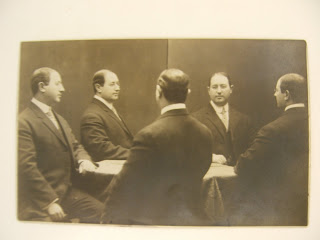This guest post is brought to you by the Rosenbach fall collections intern Jessica Walthew. When, where and how was this interesting photo taken?
When, where and how was this interesting photo taken?
Clue #1: This “photo-multigraph” shows five Dr. Rosenbachs seated around a table. Photo multigraphs are an example of a type of trick photography that was popular at the end of the 19th century and into the early 20th century. These trick photographs were made by photographing the sitter from the back while seated at a table. Using two mirrors placed at a 75 degree angle to each other creates a quintuple reflection of the sitter from the point of view of the photographer, an illusion that makes it look like five of the same person are sitting down together. This type of photograph is quite rare, and photo collectors have done some serious digging to try to find out more about the intriguing subjects and set-ups pictured in photos like these.
Clue #2: Though these photo-multigraphs could have been made in many cities around the world and examples from Argentina, Canada, Spain, Austria and New York City have been published, figuring out where our photo was taken is very easy. On the verso, the postcard is labeled “Myers-Cope Co., 1521 & 1635 Boardwalk, Atlantic City, NJ.” Though examples are scare today, many of the surviving examples of photo-multigraphs were made to commemorate trips to Atlantic City’s famous boardwalk. Heinz-Werner Lawo, a German photo collector, has many examples of photo multigraphs catalogued on his blog, including 18 from the Myers-Cope Company. Thanks to Herr Lawo’s blog we can look at some similar examples from the same studio in order to figure out when our photo of Dr. Rosenbach was taken. Of the photos posted to the multigraphs blog, we can see that our postcard looks most similar to the ones from 1910-1920, but are there any other clues that might help us?
Clue #3: Since this picture postcard was never mailed, we have yet another clue to when it might have been taken. The stamp box in the upper right hand corner of these postcards could have been decorated with a few different types of imprints with different designs surrounding where the stamp would be placed and these designs may have changed over time. Some of the known examples of photo-multigraph postcards were indeed mailed, and these have a postmark giving us a date that we can assume is close to when they were taken! Unfortunately, the stamp covers up the stamp box, so we can’t compare these known dates to our mysterious postcard of Dr. Rosenbach. If we can find an example of a similar postcard with a known date, we could narrow down our range even more, but perhaps we’ll have to leave a little bit of mystery remaining for future investigators to explore.
For more on photo-multigraphs see: (1) Heinz-Werner Lawo’s blog: (2) Dr. Irwin Reichstein’s talk for the Photographic Historical Society of Canada on the history of the multigraph:
